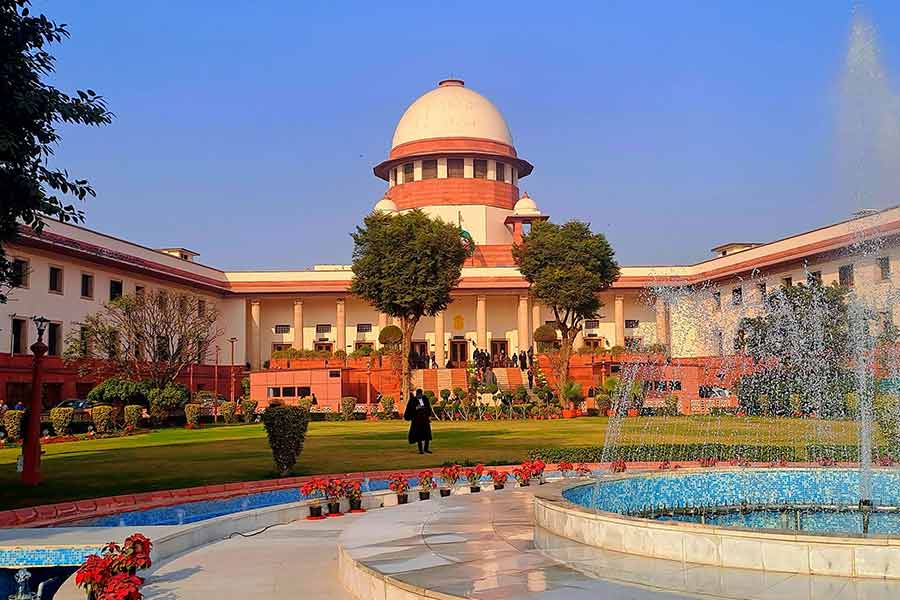The Supreme Court on Monday directed the Uttarakhand government to restore and repair ecological damage at the Corbett Tiger Reserve caused by illegal tree-felling and unauthorised construction.
The bench led by Chief Justice of India B.R. Gavai ordered all illegal structures, as identified by the court, to be demolished within three months.
The court's Central Empowered Committee will oversee the implementation of the restoration plan.
The court also said only eco-tourism would be permitted.
"With regard to the tiger safari... we have issued guidelines. We have held that it has to be in consonance with the 2019 rules. Rescue centres to be established and aid in treatment and care. Such centres to be near the tiger safaris. The number of vehicles needs to be regulated," the bench stated.
CJI Gavai summed up the ruling: “In a nutshell, we have held that if tourism has to be promoted, it has to be eco-tourism.”
Last year’s scandal, when about 6,000 trees were illegally felled in Corbett, weighed heavily on the court’s decision.
Mining ban near sanctuaries
Just a day before handing down the Corbett judgment, the Supreme Court issued another significant order. It banned all mining activity within a kilometre of any national park or wildlife sanctuary across India.
The bench, led by CJI Gavai and Justice K. Vinod Chandran, noted that unregulated mining poses a direct threat to wildlife.
Noise, dust, pollution, and habitat fragmentation were cited as key dangers. The Court ordered states to re-evaluate existing mining leases that fall within the buffer zone; leases that violate the new regime must be canceled or modified to comply.
Saranda and Sasangdaburu, Jharkhand
The Supreme Court’s mining ban draws from precedent.
In the case of the Saranda and Sasangdaburu forests in Jharkhand, the court in October directed the state government to declare both areas as wildlife sanctuaries. Originally proposed in 1968, the move had been stalled for decades. Now, the court has revived it, ordering immediate notification.
The order came after the Court noted the pressing need to protect the forest’s distinct biodiversity from illicit mining and deforestation..
The court made it clear that tribal rights under the Forest Rights Act must be fully respected.
Activists had long argued that the sal-dominated ecosystem is not only critical for elephants, bison and rare birds but also for the forest-dwelling communities who depend on it.
The top court held that the word “forest” is not limited to officially notified areas but must be understood in its ordinary sense. As a consequence, many regions, previously outside formal records, came within the fold of legal protection.
Tiger corridors across MP, Maharashtra
In September, the Supreme Court turned its attention to another worrying trend: poaching networks that operate outside formal tiger reserves.
A petition, based on a special investigation team (SIT) report, accused organised crime syndicates of targeting tigers in corridors between tiger reserves in Madhya Pradesh and Maharashtra, smuggling tiger parts across international borders.
Lawyer Gaurav Kumar Bansal submitted the petition, highlighting the fact that nearly 30 per cent of India’s tigers roam outside officially protected zones and these areas are under-monitored.
The SIT report named smugglers, hawala operators and local tribal communities as part of a trafficking chain.
The top court issued notice to the Centre, demanding a response and has also issued formal notice to the National Tiger Conservation Authority.
Sariska: Boundary redrawing and mining
Sariska’s story is one of the most fraught in India’s conservation history.
In 2024, the Supreme Court ordered all mining within a kilometre of its Critical Tiger Habitat (CTH) to halt.
In April 2025, however, controversy erupted again. State authorities proposed redrawing Sariska’s boundaries, removing around 48.39 sq km of what they called “human-impacted terrain” from the CTH, and compensating by adding 90.91 sq km from the buffer zone.
The renaming would allow more than 50 mines to reopen.
Environmentalists congregated at Delhi’s Jantar Mantar to protest. They said that the reclassification would undermine genuinely critical habitat.
The apex court has now sent the Sariska Tiger Reserve boundary proposal for public consultation. It has mandated that the proposal to redraw the boundaries of the Sariska Tiger Reserve (STR) undergo review from local communities before any final decisions are made.
Ecologist Dr Dibyadeep Chatterjee told The Telegraph Online in an earlier interview that labeling terrain “degraded” without ecological assessments such as prey density studies, camera trap data, and mapping could be catastrophic for long-term tiger recovery.
Jim Corbett’s earlier battle
In 2013, the Supreme Court ruled in favour of returning the New Kalagarh Irrigation Colony, made up of 784 families, to the Corbett Tiger Reserve.
The land had been temporarily used during the construction of the Ramganga Hydel Project in the 1960s, on the condition that structures be temporary (mud houses) and reverted to forest land after completion.
That agreement was violated, and outsiders established permanent dwellings.
The court rejected a plea to retain an ‘engineer’s academy’ inside the reserve and ordered the relocation of settlers. Ashok Kumar of the Wildlife Trust of India hailed the verdict as “a great victory for tigers, elephants and other wildlife of Corbett.”
By intervening where commercial interests threaten conservation, the Supreme Court has often acted as guardian of India’s wild. Its Corbett order on Monday is not a one-off.













